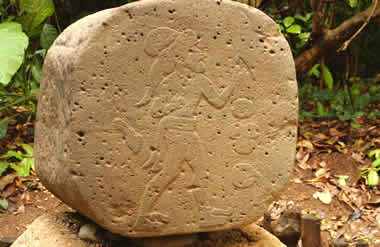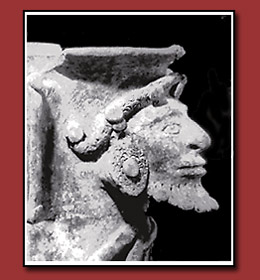Bearded Foreigners in America
by V. Garth Norman
American anthropologists, who are steeped in isolationist evolution theory in the origin and development of ancient American civilizations, tend to avoid the subject of significant trans-oceanic contacts of the type recorded in the Book of Mormon. However, the late leading Mesoamerican art historian, Tatiana Proskouriakoff published a paper in 1968 in which she recognized the Preclassic bearded figures on LaVenta sculpture (Late Olmec/Jaredite and early Mulekite time period) as "bearded foreigners". But she did not suggest an obvious Middle Eastern origin from lack of concrete evidence, where Mediterranean and Atlantic seafarers were vital to trade networks of that civilization. Heavy bearded figures dating to early Nephite times are prominent on lzapan as well as La Venta sculpture (for example, lzapa Stelae 5, 11, 67; La Venta Stela 3 and Altar 3).
It is a fact that American Indians do not have much facial hair to grow beards (Wirth 1986, p. 29, citing Sylvanus G.Morley1956, p. 23). So how are the numerous sculptures and the terracotta portraits of heavy bearded "lndians" explained? Considering their prominence, there had to be another dominant racial type in the high cultures of Mesoamerica that no longer exists. A logical explanation is provided in the decline of Nephite peoples in the Book of Mormon. Mormon being a pure descendent of Lehi (3 Nephi 5:20), implies a significant number of the Nephite population retained their race of Middle Eastern origin. Nephi also saw in vision that his seed would be destroyed in a war with the Lamanites four generations after the coming of Christ (1 Nephi 12:19-20). The decline of Mormon's people in war and survivors being assimilated into the dominant Mesoamerican "Lamanite" population, must have depleted the "beard" gene pool by the time the Spaniards arrived and conquered Mesoamerica in the 16th century. Diane Wirth (1986: 32) cited a significant research by Alexander von Wuthenau (1969:a2): "l began an intensified study of pre-Columbian terracotta heads. What I was looking for were typical 'lndian' heads. lt was not long, however, before I discovered that in the early, lower levels these 'genuine Indians'were not to be found. The earliest figures encountered were those with Mongoloid characteristics, and all kinds of white people, especially Semitic types with and without beards. What is considered to be genuine Indian only developed, so far as I am able to judge on the strength of these terracotta representations, in early and middle Classic times, and probably derived from earlier types." Kirk Magleby in a FARMS paper did a statistical analysis of more than 230 bearded figures in
Mesoamerican art and found a remarkably even distribution throughout this high civilization area. Although bearded figures date from all time periods, Magleby found that they were more frequent during Book of Mormon times before A.D. 300, and became relatively rare by Spanish contact times.





